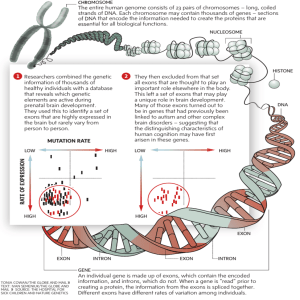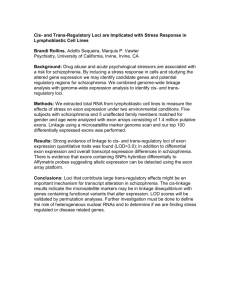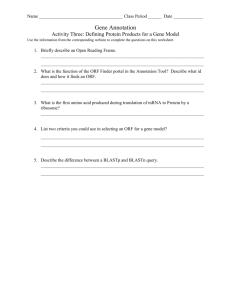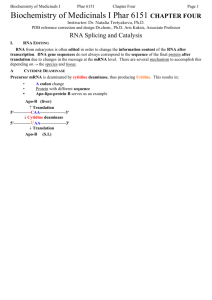03-131 Genes Drugs and Diseases Problem Set
advertisement
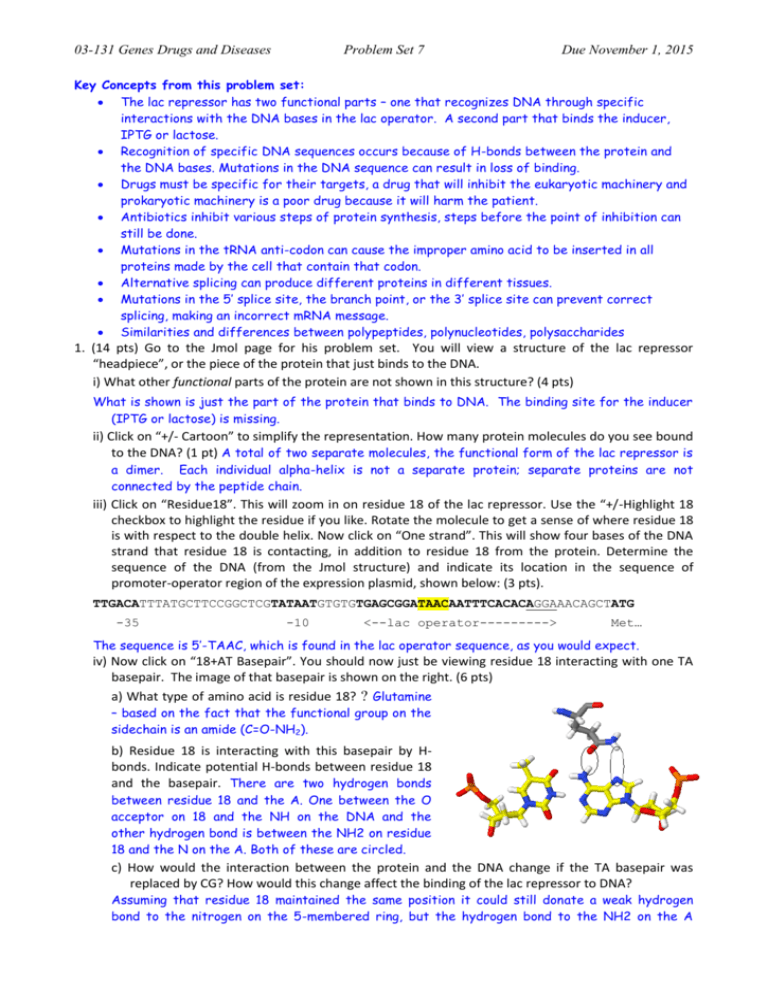
03-131 Genes Drugs and Diseases Problem Set 7 Due November 1, 2015 Key Concepts from this problem set: The lac repressor has two functional parts – one that recognizes DNA through specific interactions with the DNA bases in the lac operator. A second part that binds the inducer, IPTG or lactose. Recognition of specific DNA sequences occurs because of H-bonds between the protein and the DNA bases. Mutations in the DNA sequence can result in loss of binding. Drugs must be specific for their targets, a drug that will inhibit the eukaryotic machinery and prokaryotic machinery is a poor drug because it will harm the patient. Antibiotics inhibit various steps of protein synthesis, steps before the point of inhibition can still be done. Mutations in the tRNA anti-codon can cause the improper amino acid to be inserted in all proteins made by the cell that contain that codon. Alternative splicing can produce different proteins in different tissues. Mutations in the 5’ splice site, the branch point, or the 3’ splice site can prevent correct splicing, making an incorrect mRNA message. Similarities and differences between polypeptides, polynucleotides, polysaccharides 1. (14 pts) Go to the Jmol page for his problem set. You will view a structure of the lac repressor “headpiece”, or the piece of the protein that just binds to the DNA. i) What other functional parts of the protein are not shown in this structure? (4 pts) What is shown is just the part of the protein that binds to DNA. The binding site for the inducer (IPTG or lactose) is missing. ii) Click on “+/- Cartoon” to simplify the representation. How many protein molecules do you see bound to the DNA? (1 pt) A total of two separate molecules, the functional form of the lac repressor is a dimer. Each individual alpha-helix is not a separate protein; separate proteins are not connected by the peptide chain. iii) Click on “Residue18”. This will zoom in on residue 18 of the lac repressor. Use the “+/-Highlight 18 checkbox to highlight the residue if you like. Rotate the molecule to get a sense of where residue 18 is with respect to the double helix. Now click on “One strand”. This will show four bases of the DNA strand that residue 18 is contacting, in addition to residue 18 from the protein. Determine the sequence of the DNA (from the Jmol structure) and indicate its location in the sequence of promoter-operator region of the expression plasmid, shown below: (3 pts). TTGACATTTATGCTTCCGGCTCGTATAATGTGTGTGAGCGGATAACAATTTCACACAGGAAACAGCTATG -35 -10 <--lac operator---------> Met… The sequence is 5’-TAAC, which is found in the lac operator sequence, as you would expect. iv) Now click on “18+AT Basepair”. You should now just be viewing residue 18 interacting with one TA basepair. The image of that basepair is shown on the right. (6 pts) a) What type of amino acid is residue 18? ? Glutamine – based on the fact that the functional group on the sidechain is an amide (C=O-NH2). b) Residue 18 is interacting with this basepair by Hbonds. Indicate potential H-bonds between residue 18 and the basepair. There are two hydrogen bonds between residue 18 and the A. One between the O acceptor on 18 and the NH on the DNA and the other hydrogen bond is between the NH2 on residue 18 and the N on the A. Both of these are circled. c) How would the interaction between the protein and the DNA change if the TA basepair was replaced by CG? How would this change affect the binding of the lac repressor to DNA? Assuming that residue 18 maintained the same position it could still donate a weak hydrogen bond to the nitrogen on the 5-membered ring, but the hydrogen bond to the NH2 on the A 03-131 Genes Drugs and Diseases Problem Set 7 Due November 1, 2015 would be lost since this group is an oxygen in G. decrease. The binding strength to the DNA would 2. (5 pts) α-Amanitin is a natural product that is a potent inhibitor of eukaryotic RNA polymerase. i) What are the consequences to the cell of inhibiting its RNA polymerase? It cannot make mRNA, and therefore cannot make proteins – this is lethal. ii) Where is α-Amanitin produced – what organism makes it (please use the web)? Mushrooms – toxic ones. iii) Both rifampicin and α-Amanitin inhibit RNA synthesis. Rifampicin can be used to treat bacterial infections, but α-Amanitin cannot. Why? α-Amanitin inhibits eukaryotic RNA polymerase, therefore it would kill the patient, not the bacteria causing the infection. This is why these mushrooms are toxic. Death occurs 2-3 days after eating the mushrooms, unless a liver transplant is possible. 3' 3. (5 pts) A genetic mutation changes the aminoacyl tRNA synthase that normally adds the aminoacid Phe to tRNAPhe (tRNAPhe is the tRNA that normally brings the amino acid phenylalanine to the ribosome). The mutation causes the enzyme to also add Phe to a tRNA that has the sequence 3’-CCA-5’ as its anticodon. How will this mutation affect protein synthesis and the sequence of proteins that are produced by the ribosome? 5' tRNA -C-C-AmRNA 5'-----G-G-U--------3' The anticodon sequence 3’-CCA-5’ will recognize GGU (GGT) codons, this is the codon that normally codes for the amino acid glycine. Thus phenylalanine residues will be incorporated into the polypeptide chain where there should be glycine. 4. (5 pts) The antibiotic Azithromycin binds to the exit tunnel of the prokaryotic ribosome. It was originally isolated from a soil fungus. Its structure is shown on the right. i) What are the typical uses of this antibiotic (please cite your source)? Treat various bacterial infections, there are many species of bacteria that are sensitive. ii) Which steps of protein synthesis could still occur and which would be prevented in the presence of this antibiotic? The ribosome would be able to initiate protein synthesis and even add a few amino acids, but then it would stop synthesis because elongation would no longer be possible. iii) Why would a soil fungus produce azithromycin? Fungi are eukaryotic and need to protect themselves from bacterial infections. 5. (5 pts) The antibiotic amikacin binds to the A-site in the prokaryotic ribosome. Its structure is shown on the right. Which steps of protein synthesis could still occur and which would be prevented in the presence of this antibiotic? The initiation complex of 30s+50s+mRNA+tRNAfMET could still form, but no amino acids could be added since the incoming aminoacids (and the tRNA they are attached to) have to bind to the A site as the first step in the addition of new amino acids. 6. (15 pts) A pre-mRNA contains three exons, A, B, C (the “A” represents the branchpoint). A A Exon A Exon B Exon C i) How many different mRNAs could be made after splicing, justify your answer (5 pts)? In alternative splicing, one or more exons are not incorporated into the final message, but the order is preserved. There are only two possibilities here if you consider how the mRNA are spliced: 03-131 Genes Drugs and Diseases Problem Set 7 Liver ABC (both splice sites are used) AB (only the first splice site is used) Exon A AC (only the second splice site is used) A (none of the splice sites are used) Other possible combination is BC – but this Exon A would require that exon B had a start codon. B and C as single exons were also accepted, Exon A but they would also have to have start codons to produce a useful mRNA. Due November 1, 2015 A A Exon B Exon C A A Exon B Exon C A Exon B Exon C A ii) In one tissue (e.g. liver), the final mRNA Muscle contains only exons A and B, while in another A A Exon A Exon B Exon C tissue (e.g. muscle) the final mRNA contains exons A and C. Illustrate the mechanism by which these two final mRNAs are made. A A 7. (5 pts) IGHD II (familial isolated growth hormone Exon A Exon B Exon C deficiency type II) is a genetic deficiency that affects the production of a growth hormone that Exon A Exon C is needed for the proper development of the A A newborn. You sequence the DNA that encodes Exon B the growth hormone from a normal and two affected individuals. The sequence between two of the exons are shown below (exons are in bold and underlined), this sequence is of the pre-mRNA (before splicing). Normal Individual: AAUUCGGU---------A----------AGAGGUGG Affected Individual 1: AAUUCGUU---------A----------AGAGGUGG Affected Individual 2: AAUUCGGU---------T----------AGAGGUGG i) What will the mRNA sequence be after splicing, for the normal individual? AAUUCGAGGUGG ii) What is causing the deficiency in the affected individuals? There are no changes in the exons, so the coding region after splicing would be the same for all. Therefore, there must be a problem with the sequences that are used for splicing. Individual 1 has a mutation in the 5’ splice site (GU→UU) while individual 2 has the branch site A replaced by T. In both cases, splicing does not occur and the intron is left in the mRNA, changing the final protein sequence. 8. (5 pts) For the two (A,B) polysaccharides shown to the right. i) Describe the linkages which connect the monomer units. ii) Name these two polysaccharides. iii) Which one is used for energy storage in most organisms? A B A is glycogen (or starch) contains α(1-4) and α(1-6) linkages – this is used for glucose (energy) storage. B is cellulose with (1-4) linkages between the glucose units. It is used for cell structure. 9. (5 pts) List the similarities and differences between polysaccharides, proteins, and nucleic acids (e.g. monomeric units, connection between units, branching). Monomeric units Connection Branching polysaccharides monosaccharides Glycosidic bond Yes proteins Amino acids Peptide bond No (but crosslinked via disulfide bonds can occur) Nucleic acids Nucleobases Phosophodiester bond No

